There are at least a half-million species of plants in the world. Although they do not contain living souls,1 plants nevertheless display incredible design features and complex interactions with other plants and insects. Plants have immune systems that seem to be every bit as biochemically complex as those in vertebrates. Botanists have discovered that a plant can distinguish a nematode (tiny parasitic roundworm) from a virus, actively resist a penetrating mold, and produce odors to defend itself against a feeding caterpillar.2 Indeed, the Creator has designed plants with chemical detectors that are precise enough to discern between a beetle and a caterpillar.
Plant resistance is a whole new field (so to speak) of botany that has bloomed in recent decades. Fascinating discoveries include proteins produced by plants that are toxic to invading microbes, and toxic soap-like compounds called saponins that are designed to resist plant pathogens such as various fungi. Other effective anti-fungal chemicals include cysteine-rich peptides called defensins, which are found in people as well as plants. This fact does not necessarily indicate that plants and people came from a common ancestor. On the contrary, if they had the same Designer, we would expect that He might have provided them both with effective fungistats.
Far from being inert entities that merely provide us with food and aesthetic value, plants can actively respond to their environments by adjusting their looks and growth--and even their behavior, from defensive to aggressive. For instance, plants can wage chemical warfare against other plants. In 2003, researchers from Colorado State University found that the roots of the spotted knapweed produce a natural herbicide called catechin that causes nearby plants to self-destruct. When these plants die due to a specific series of biochemical reactions caused by the catechin, the spotted knapweed takes over their territory.3
In fact, plants even seem to have a sophisticated social life! One study showed that a wildflower called a sea rocket was less competitive with those of the same species, but more aggressive with others. The authors state, "Our results demonstrate that plants can discriminate kin in competitive interactions and indicate that the root interactions may provide the cue for kin recognition."4
How do neo-Darwinists respond to such clear evidence of design? A decade ago, in a chapter titled "The New Darwinism," retired Australian evolutionary scientist S. A. Barnett wrote:
The transformations revealed by modern biology are, however, not directed by any overriding agency. Biologists can no longer present organisms as the product of an intelligent designer.5
This pronouncement is not based on empirical science, but upon the author's naturalistic worldview. He credits natural selection of mutations as "the only credible explanation."6 But natural selection is not the powerful mechanism that its supporters envision. One reason to doubt the neo-Darwinian story is that 80 percent of mutations are so slight that they are invisible to selection.7 Also, realistic ratios of beneficial to deleterious mutations hover around 1:1 million.8 Therefore, the deleterious ones relentlessly accumulate, cannot be selected "out," and eventually lead to fatal data corruption.
Natural selection at most accounts for some members of a population surviving in greater numbers, but it leaves the less fortunate ones unfit for survival. This might lead to extinction of certain breeds, but not to the invention of a whole new organism, useful body part, or a single cell, much less the complex biochemical communication systems in plants. There is a more convincing explanation for the origin of plants, with their capacity for minor variations, but it would give glory and honor to the Creator, not to His creation.
References
- Morris, J. 1991. Are Plants Alive? Acts & Facts. 20: (9).
- Sherwin, F. 2005. All Out War in the Cornfield. Acts & Facts. 34 (8).
- Bias, H. P. et al. 2003. Allelopathy and Exotic Plant Invasion: From Molecules and Genes to Species Interactions. Science. 301: 1377-1380.
- Dudley, S. and A. File. 2007. Kin recognition in an annual plant. Biology Letters. 3 (4): 435-438.
- Barnett, S. A. 1998. The Science of Life. Australia: Allen & Unwin, 215.
- Ibid, 214.
- Kimura, M. 1979. Model of effectively neutral mutations in which selective constraint is incorporated. Procedures of the National Academy of Science. 76 (7): 3440-3444.
- Gerrish, P. J. and R. E. Lenski. 1998. The fate of competing beneficial mutations in an asexual population. Genetica. 102/103: 127-144.
* Mr. Sherwin is Senior Science Lecturer.
Cite this article: Sherwin, F. 2008. Complex Plant Systems: Rooted in God's Genius. Acts & Facts. 37 (11): 14.




